Never give up: how Netscape waged an unequal battle with Internet Explorer
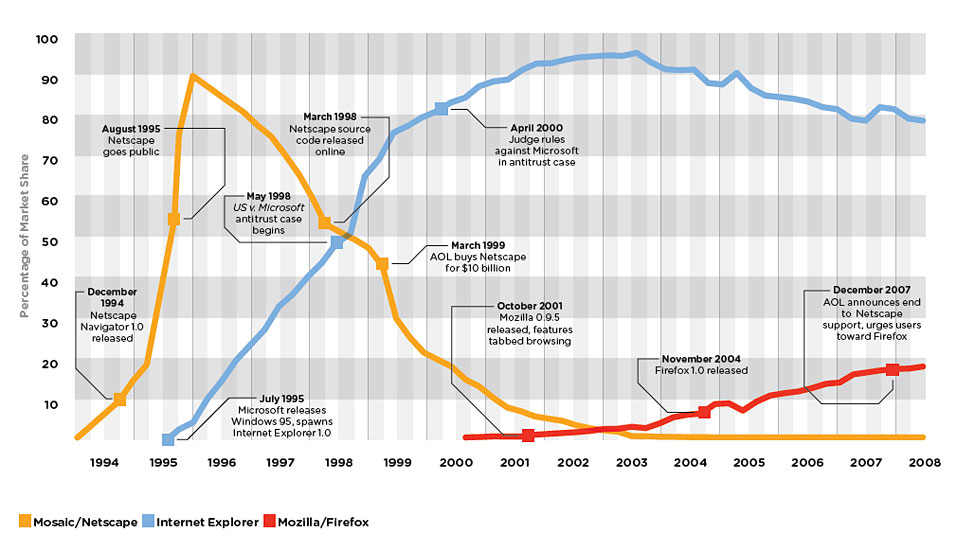
Source: wired.com
It is believed that the first browser appeared December 25, 1990. Its founder was Tim Berners-Lee, a junior member of the European Organization for Nuclear Research. According to him, the development did not take much time (about two months), because he used the platform with a special application designer. Tim created the so-called World Wide Web Consortium (W3C), which developed the standards implemented in the software.
By the end of 1992, besides the very first browser called WorldWideWeb, many others appeared on the market, most of which were based on the libwww library - Line Mode Browser, ViolaWWW, Erwise, MidasWWW, MacWWW and others. The next browsers released in 1993 were Cello, Arena, Lynx, tkWWW, and NCSA Mosaic.
')
Mosaic, a multiplatform browser, was developed by the National Center for Supercomputing Applications (NCSA). In October 1994, Mosaic was on its way to becoming the reference interface for the whole world. Several companies licensed Mosaic to create their own commercial browsers, such as AirMosaic and Spyglass Mosaic.
One Mosaic developer, Mark Andriessen, founded Mosaic Communications Corporation and created a new web browser called Mosaic Netscape. To resolve licensing issues with NCSA, the company was renamed Netscape Communications Corporation, and the browser was renamed Netscape Navigator. The Netscape browser has improved the convenience and reliability of Mosaic and was able to display pages gradually as they load.
By 1995, thanks to its gratuity for non-commercial use, the browser dominated the network. By this time, several more browsers were released, including IBM Web Explorer, WebRouser, UdiWWW, and Microsoft Internet Explorer.
By mid-1995, the Internet received widespread coverage in popular culture and media. Netscape Navigator was the most widely used web browser, and Microsoft acquired the Mosaic license to create Internet Explorer 1.0, released as part of the Windows 95 Plus! in August. Three months later, Internet Explorer 2.0 was uploaded for free download. Unlike Netscape Navigator, it was available for free to all Windows users, even to commercial companies.
New versions of Internet Explorer and Netscape browsers were released over the next few years, trying to outrun each other.
IE history
The project to develop Internet Explorer was launched in 1994 by Thomas Reardon. According to a MIT review in 2003, he used the source code of the Mosaic program developed by Spyglass, Inc., which is formally associated with the NCSA Mosaic browser.
The first version of Internet Explorer, Microsoft Internet Explorer, was released on August 16, 1995 and was a redesigned version of the Spyglass Mosaic browser.

IE 1.0
A number of innovations proposed by Internet Explorer were later used by other browsers. These include the HTML iframe element, which allows embedding some HTML documents into others (was added in Internet Explorer 3), an icon for favorites (favicon) that appeared in Internet Explorer 4, and a property for dynamically updating the contents of innerHTML elements in Internet Explorer 4 .
XMLHttpRequest was developed for Internet Explorer 5, which allowed to make HTTP requests to the server without reloading the page. This version also introduced a way to capture and drag elements (drag-and-drop), which was standardized in HTML5 almost unchanged and now supported by almost all web browsers.

IE 5.5
Similarly, the contentEditable attribute was added, which was added in Internet Explorer 5.5 and allowed editing part of the page directly in the browser, as well as Clipboard Access from IE6, giving the browser access to the clipboard in certain situations.
Internet Explorer 6 was the first browser to integrate the P3P platform, a means of ensuring the confidentiality of user data.
Internet Explorer 7, in turn, included new features designed to ensure the security of the user and protect his confidential data from viruses and network attacks.
Windows Internet Explorer 8 (IE8) was released March 19, 2009. The version supports the second and third service packs for Windows XP, the second service pack for Windows Server 2003, Windows Vista, Windows 7 and Windows Server 2008 on 32- and 64-bit architecture. Microsoft has named security, ease of use, and improvements in support for RSS, CSS, and Ajax IE8 as top priorities in developing a new version.
The development of Windows Internet Explorer 9 began almost immediately after the release of Internet Explorer 8 and the version was released on March 14, 2011. Microsoft first announced the start of IE9 development at the PDC conference in 2009, where it focused on the advantages of DirectX hardware acceleration for improving web application performance.
Internet Explorer 9 is intended only for Windows Vista SP2, Windows 7 and Microsoft Windows Server 2008. The browser supports some of the features of CSS 3, native support for color ICC profiles version 2 or 4 through the Windows Color System. The 32-bit version has better javascript performance thanks to a module called “Chakra”.
Internet Explorer 9 was the first browser to use graphics hardware acceleration using the Direct2D application programming interface.
Internet Explorer 10 was released on October 26, 2012 along with Windows 8 and Windows Server 2012. For Windows 7, the version became available on February 26, 2013. In Windows 8, the browser is divided into two versions: the first version of the browser, created from scratch to control on touch devices - in the Modern UI interface without plug-in support, the second is the traditional desktop application, which preserves the possibility of expansion through plug-ins. This version of the browser has improved support for JavaScript, CSS3 and HTML5, and hardware acceleration.
Internet Explorer 11 was released in a Windows 8.1 update that was introduced on October 17, 2013.
This release included improved scaling for screens with large extensions, HTML5 preloading, mouse movement, hardware accelerated decoding of JPEG images, and HTML5 full screen mode.
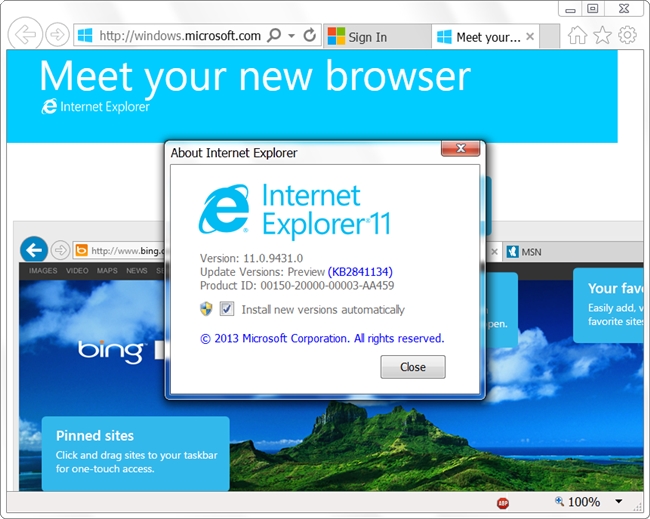
IE 11
Internet Explorer 11 is the first version to support WebGL555657 and the SPDY protocol (since version 3).
Microsoft said that Internet Explorer 11 when passing the benchmark for performance measurement JavaScript SunSpider is the fastest browser for Windows as of October 15, 2013.
After the release of Windows 10, developers have replaced IE with a new browser - Microsoft Edge.
Netscape Browser History
Netscape Navigator is a browser produced by Netscape Communications from 1994 to 2007. The first beta versions of the browser, released in 1994, were called Mosaic, then Mosaic Netscape.
At the time of creation, the browser had the most extensive capabilities, which ensured its leadership in the market, despite the fact that it existed then in the form of a beta version. After the release of version 1.0, the market share continued to grow rapidly.

Netscape Navigator 1.1
In version 2.0, a full-featured email program was built. Netscape has evolved from a simple browser to a family of programs for working on the Internet. During this period, the browser itself and the program family bore the same name - Netscape Navigator.
Netscape 3.0 has become the number one browser in the world. This release also existed in the Gold version containing WYSIWYG, an HTML editor that later became a standard feature of Netscape Communicator. Netscape 3.0 offered many new features, such as plug-ins, colored backgrounds for tables, the applet element.

Netscape 3.0
With the release of Netscape 4, the problem of the same name of the actual browser and the whole program family was solved: the program family was renamed Netscape Communicator.
After the release of five preliminary releases (in 1996–1997) in June 1997, Netscape Corp. released the final version of Netscape Communicator. This version was based on the updated Netscape Navigator 3 code, features such as support for some CSS1 elements, an object element, minimal support for various fonts were added to it.
The Netscape Communicator program family included the Netscape Navigator browser, the Netscape Mail and Newsgroups e-mail and newsgroups, the Netscape Address Book address book, and the Netscape Composer HTML editor.
In October 1998, version 4.5 was released. The new version has many new features, especially in the mail client. At the same time, the kernel was not updated and in its functionality basically corresponded to version 4.08.
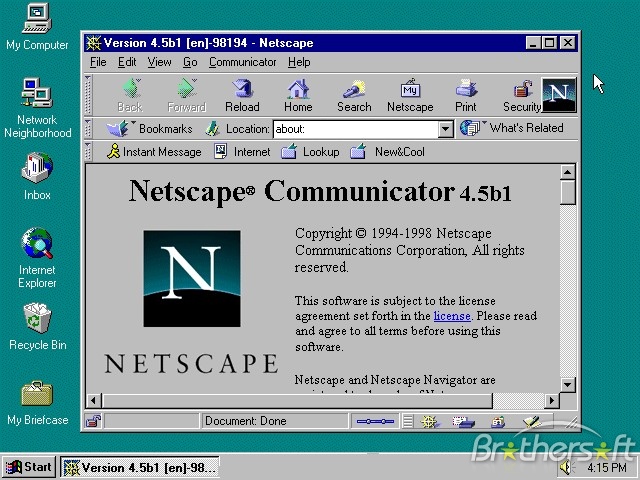
Netscape Communicator 4.5
At the same time, the problem of delays in the release of the main versions of the program has intensified. In Netscape Communicator 4.x, there was a large number of HTML and CSS processing errors, and the document object model (DOM) proposed by Netscape did not find support in the W3C, which took the version proposed by Microsoft, which was the main sponsor of the consortium at that time.
As a result, Microsoft Internet Explorer 4 (and later 5.0) has become a new market leader thanks to better support for HTML 4, CSS, DOM and ECMAScript. In November 1998, work on Netscape 5.0 was discontinued and it was decided to start developing a completely new program from scratch.
The new source code was named Mozilla, on the basis of which Netscape 6 was created with minor changes.
In January 1998, Netscape decided to develop a browser in an open source project. An informal group was created by the Mozilla Organization, which was mainly funded by Netscape.
The decision to start developing a browser from scratch meant a significant delay in the release of the next version. At this time, Netscape was absorbed by the AOL corporation, which, acting under the pressure of the Web Standards Project, accelerated the release of Netscape version 6.0: it appeared in 2000.
Version 7 (codename Mach V) became simply Netscape, the browser as part of the program family retained its name Netscape Navigator. Netscape 7.0, based on Mozilla 1.0.1 code, was released in August 2002 and was a direct sequel to Netscape 6 with the same components.
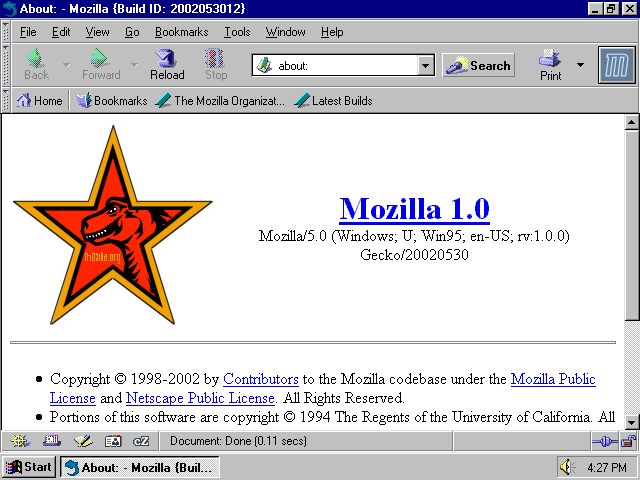
Mozilla 1.0
Netscape 8
Netscape Browser 8 is based on the Mozilla Firefox 1.0 code. Unlike its fiery brother, Netscape works only in the Windows operating system family (98SE, ME, 2000 and XP). Eight is no longer an integrated package, leaving only a browser in its arsenal. Base functionality and most user interface elements are inherited from Mozilla Firefox.
Netscape 8 allows you to use two HTML engines at the same time. The “native” browser engine is Gecko 1.7.5. In addition, the browser can connect to the Trident engine, used by Internet Explorer 5 or 6. This feature, which is present in the browser initially, provides a 100% chance of correct display of sites. With the help of a special manager, you can memorize the rules for choosing the engine for each site separately.
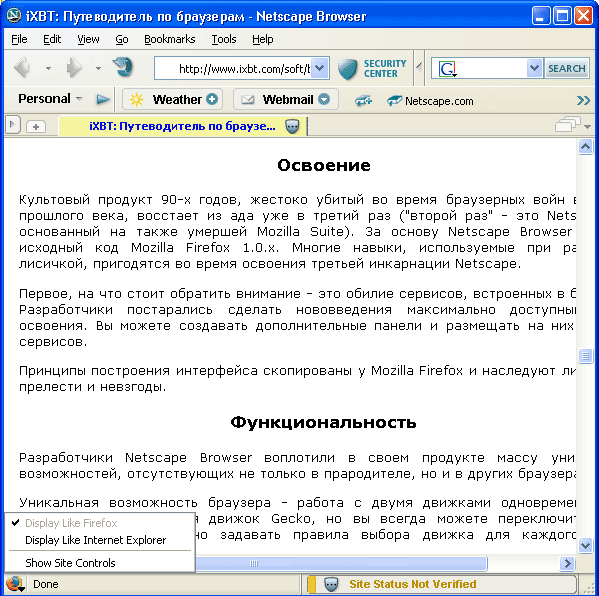
Engine selection in Netscape 8.1
The latest browser version is 9.0 called Netscape Navigator. The first beta version was released on June 5, 2007. Developed by Netscape Communications Corporation on the engine Gecko 1.9, which is used in Mozilla Firefox 2.0.
December 28, 2007, the company announced the termination of browser support and development.
Microsoft VS Netscape
A browser war would be a purely commercial business of corporations if the main method in the struggle was not to add specific, non-standard features to the browser. The biggest differences were in the support of JavaScript, a scripting language that gives interactivity to documents.
As a result, many documents were “optimized” for a specific browser and completely unreadable in another. The W3C accepts many well-discussed standards (different versions of HTML, JavaScript, CSS, and others), but compliance with these standards falls entirely on browser developers.
In 1997, Internet Explorer 4.0 was released. At the party in San Francisco in honor of the release of the program was presented three-meter logo IE. The next morning, Netscape workers, having come to work, found this construction on the lawn in front of their office, with a note “From the IE team ... We love you.”
Employees knocked down this installation and in response placed on it a figure of their corporate character - a dinosaur, attaching a sign with the inscription “Netscape 72, Microsoft 18” to their paws, meaning the distribution of market shares.
Internet Explorer 4 broke the course of the browser wars. It has been integrated into Microsoft Windows. IT professionals and industry critics considered it technologically unprofitable and saw in this practice the obvious exploitation of the Microsoft monopoly on the PC platform.
But users did not see the benefits of using competing products, because IE was already on their PC.
This is what one of the developers of IE 5.0, Hadi Partovi, told about the “victory” over Netscape:
In the mid-90s, Microsoft hired the best and most talented programmers to solve the "Internet problem", that is, the development team of the browser (IE) and server (IIS). Brad Silverberg, one of the best managers in the history of Microsoft, who was involved in market launch of the incredibly successful Windows 95 project, was assigned to lead the two development teams of vice-president Brad Silverberg.
The entire Internet Explorer development team consisted of superstars: “Our work was more than just work. It was a passion and a matter of life. We had breakfast, lunch and dinner in the workplace, we worked until late / late night, ” recalls Partovi. “We had the feeling that a multi-billion dollar company would lose its future if we didn’t jump on the Internet wave and make the number 1 browser on the planet.”
The release of Internet Explorer 5 took place on March 18, 1999. “And we made the browser twice as fast and 100 times more stable than the buggy Netscape Navigator,” writes Hadi Partovi. He is confident that due to the high quality of the program, the market share of Internet Explorer 5.0 has begun to grow, and the browser has won 100% of the benchmarks in the media.
Microsoft had powerful advantages. The first was resources — Netscape started with almost 80% of the market and a good reputation, but it was a small company that received major profits from a single product and its additional components and was therefore financially vulnerable.
Netscape was paid for commercial companies, but was supplied free for home and educational use. Internet Explorer was delivered free of charge for all Macintosh and Windows users, gaining a huge advantage from this.
Microsoft’s other strength was that Windows occupied more than 90% of the PC operating system market. In those days, many PC purchases were the first cases of such a purchase, and many users had not used any browsers before, and therefore had no items to compare and had low motivation to search for alternatives.
Trial
Netscape did not give up without a fight and in 1997 filed a lawsuit against Microsoft, accusing the company of a monopoly. The main reason for the suit was the integration of Internet Explorer into Windows, which violated the rules of fair competition.
Microsoft lawyers assumed that the browser was added at the source code level, and it is virtually impossible to remove it from the current OS version. Netscape insisted that this was a lie, and offered its own way out of the situation - a complete ban on the use of Internet Explorer. Gates had a convincing argument: using IE integration, the corporation provides its users with high-quality software, and it would be unfair to ban the browser against them.
As a result, Microsoft promised to release a version of Windows 95 without its browser, but due to appeals, the ban on integrating IE did not work on the next version of the operating system, which was soon to see the light.
As a result, the company entered into an agreement with the US Department of Justice, under which it pledged to license part of the development, allow PC manufacturers to replace software with alternative software and allow oversight of their documents. The decision was strange, especially considering that they proved in court how much weight Microsoft had at the time.
Netscape could not resist dumping, and in 1999 the corporate browser market ceased to exist - Explorer, completely free, captured more than 90 percent of the market.
To be continued
The first "browser war" ended with the victory of Internet Explorer, which captured almost 100% of the market and cut off all competitors of any serious importance. At the same time, the innovation race in browsers ended.
And even in this situation, the Netscape team did not give up and released the source code of their browser under the free MPL (Mozilla Public License) license. Based on it, new browsers Mozilla Suite and Mozilla Firefox were created. The latter was supposed to "revenge" Microsoft.
PS
This is how Habr's user remembers the best times with Netscape:
I would not be surprised if some of the readers do not know what Netscape was to us 20 years ago.
In 1994, I studied at the university where the Internet was held by an American grant. For the whole institute there was a channel of 33.6 Kbps. Yes, dear reader, 3 kilobytes per second. When your mobile phone is very slow at 12-20 kb / second on GPRS, it is 4 or more times faster than we had then on all computers in total. And there were at least twenty computers connected to the Internet, and quite often they were all busy.

We opened Netscape (other browsers and did not know), entered URLs that were written out in a notebook, which were usually written out from paper magazines (Yahoo will appear only after a year, in 1995, I don’t talk about Google).
And waited. They waited for three to five, and sometimes ten minutes until the page opens. For us, it was a miracle - to see a web page that was located thousands of kilometers from us. We turned off the pictures so that you can download at least something. Video? Audio? Flash? This we did not even dream.
I burned the Netscape browser onto several 3.5-inch floppy disks, brought it home and started learning the HTML language. Soon I made my first web page.
Yes, the Internet was for us so ... warm, tube.
Source: https://habr.com/ru/post/304344/
All Articles